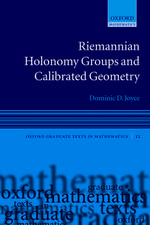Curved Spaces: From Classical Geometries to Elementary Differential Geometry
Autor P. M. H. Wilsonen Limba Engleză Paperback – 12 dec 2007
| Toate formatele și edițiile | Preț | Express |
|---|---|---|
| Paperback (1) | 461.54 lei 6-8 săpt. | |
| Cambridge University Press – 12 dec 2007 | 461.54 lei 6-8 săpt. | |
| Hardback (1) | 902.59 lei 6-8 săpt. | |
| Cambridge University Press – 12 dec 2007 | 902.59 lei 6-8 săpt. |
Preț: 461.54 lei
Nou
Puncte Express: 692
Preț estimativ în valută:
88.33€ • 91.25$ • 73.51£
88.33€ • 91.25$ • 73.51£
Carte tipărită la comandă
Livrare economică 26 martie-09 aprilie
Preluare comenzi: 021 569.72.76
Specificații
ISBN-13: 9780521713900
ISBN-10: 0521713900
Pagini: 198
Ilustrații: 79 b/w illus. 105 exercises
Dimensiuni: 170 x 244 x 11 mm
Greutate: 0.41 kg
Editura: Cambridge University Press
Colecția Cambridge University Press
Locul publicării:Cambridge, United Kingdom
ISBN-10: 0521713900
Pagini: 198
Ilustrații: 79 b/w illus. 105 exercises
Dimensiuni: 170 x 244 x 11 mm
Greutate: 0.41 kg
Editura: Cambridge University Press
Colecția Cambridge University Press
Locul publicării:Cambridge, United Kingdom
Cuprins
Preface; 1. Euclidean geometry; 2. Spherical geometry; 3. Triangulations and Euler numbers; 4. Riemannian metrics; 5. Hyperbolic geometry; 6. Smooth embedded surfaces; 7. Geodesics; 8. Abstract surfaces and Gauss-Bonnet.
Recenzii
'… the patient reader will acquire substantial techniques and methods that are part of differential geometry and along with that, much, much more. … The book is certainly a welcome addition to the literature. It is clear to the reviewer the the text is a labour of love' Mathematical Reviews
'This book paves its way through a number of geometries with a clear intent: to promote the understanding of the basic concepts in differential geometry. The classical 2-dimensional geometries such as Euclidean, spherical and hyperbolic geometry are the first few steps. The geometry of the torus, triangulations and Euler numbers are further issues. Every chapter is followed by an assortment of helpful examples. The chapters gently direct the reader [towards] Riemannian metrics and further to geodesics and abstract surfaces. The Theorema Egregium and Gauss-Bonnet Theorem are also given ample attention. What distinguishes this book from other lecture notes on elementary differential geometry? The author does not abruptly define concepts which otherwise never would have come to the reader's mind. He rather conveys the ideas, subtly initiated in the former chapters. In this sense the book is remarkably self-contained. On the other hand the author does not shun detailed proofs. All these ingredients make for a successful volume.' Johann Lang, Zentralblatt MATH
'Curved Spaces provides an elegant, sophisticated treatment of two-dimensional geometries suitable for advanced undergraduates … Overall, Wilson has provided a monograph that could ably serve for an excellent undergraduate capstone experience … Highly recommended.' S.J. Colley, CHOICE
'The book is written in a nice and precise style and explicit computations and proofs make the book easy to understand. A detailed and explicit discussion of the main examples of classical geometries contributes well to a better understanding of later generalisations. A list of examples at the end of each chapter helps as well. It is a very good addition to the literature on the topic and can be very useful for teachers preparing their courses as well as for students.' EMS Newsletter
'This book paves its way through a number of geometries with a clear intent: to promote the understanding of the basic concepts in differential geometry. The classical 2-dimensional geometries such as Euclidean, spherical and hyperbolic geometry are the first few steps. The geometry of the torus, triangulations and Euler numbers are further issues. Every chapter is followed by an assortment of helpful examples. The chapters gently direct the reader [towards] Riemannian metrics and further to geodesics and abstract surfaces. The Theorema Egregium and Gauss-Bonnet Theorem are also given ample attention. What distinguishes this book from other lecture notes on elementary differential geometry? The author does not abruptly define concepts which otherwise never would have come to the reader's mind. He rather conveys the ideas, subtly initiated in the former chapters. In this sense the book is remarkably self-contained. On the other hand the author does not shun detailed proofs. All these ingredients make for a successful volume.' Johann Lang, Zentralblatt MATH
'Curved Spaces provides an elegant, sophisticated treatment of two-dimensional geometries suitable for advanced undergraduates … Overall, Wilson has provided a monograph that could ably serve for an excellent undergraduate capstone experience … Highly recommended.' S.J. Colley, CHOICE
'The book is written in a nice and precise style and explicit computations and proofs make the book easy to understand. A detailed and explicit discussion of the main examples of classical geometries contributes well to a better understanding of later generalisations. A list of examples at the end of each chapter helps as well. It is a very good addition to the literature on the topic and can be very useful for teachers preparing their courses as well as for students.' EMS Newsletter
Notă biografică
Descriere
This 2007 textbook uses examples, exercises, diagrams, and unambiguous proof, to help students make the link between classical and differential geometries.


















